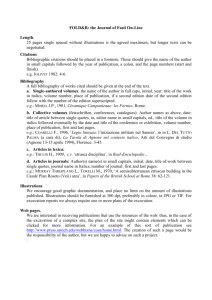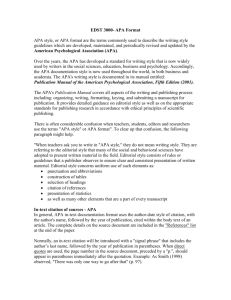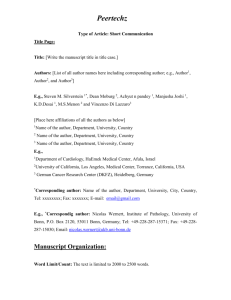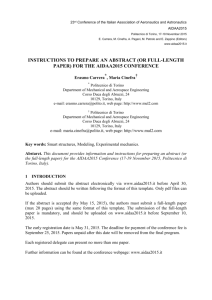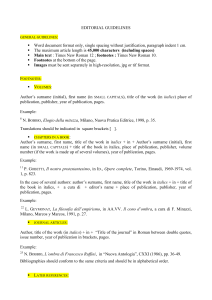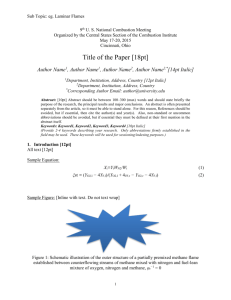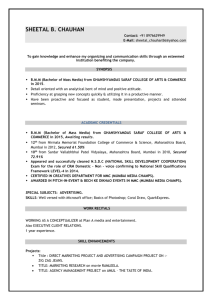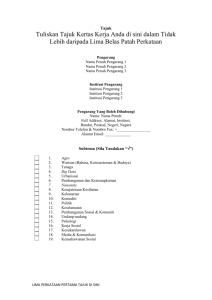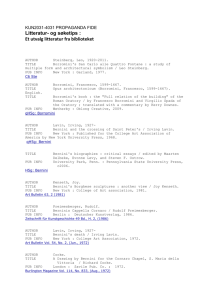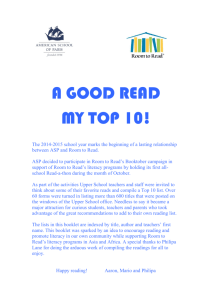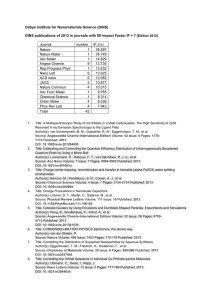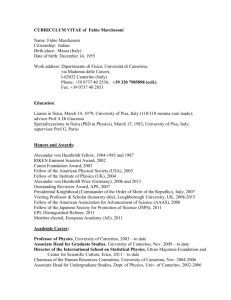methods - LIMNOTEK
advertisement
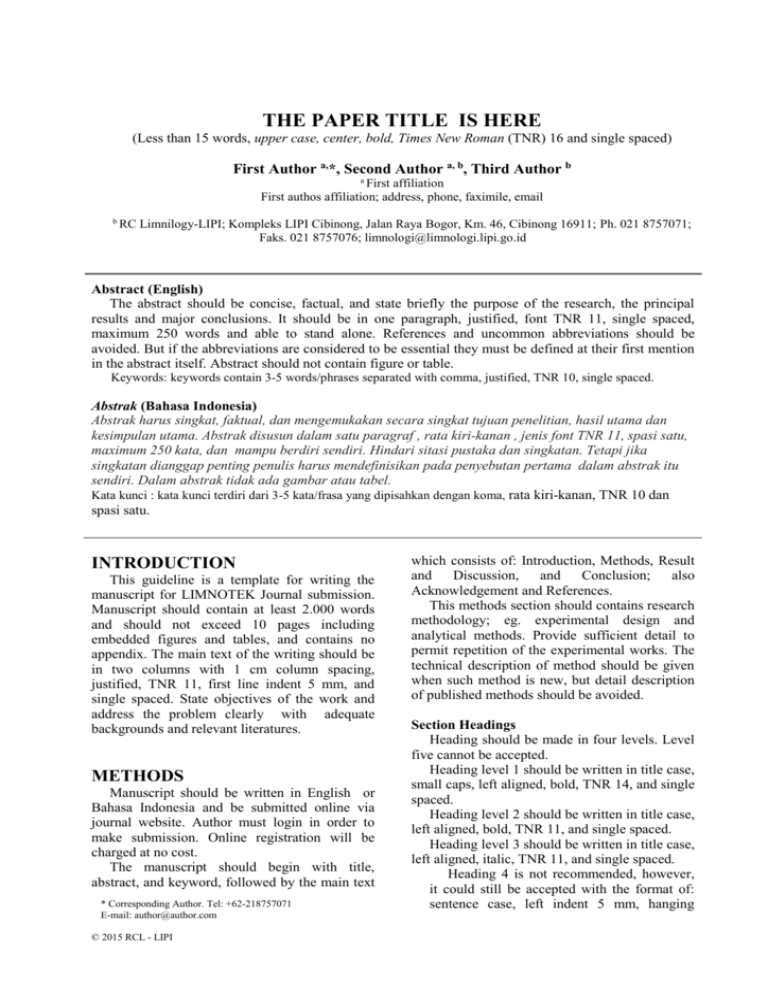
THE PAPER TITLE IS HERE (Less than 15 words, upper case, center, bold, Times New Roman (TNR) 16 and single spaced) First Author a,*, Second Author a, b, Third Author b a First affiliation First authos affiliation; address, phone, faximile, email b RC Limnilogy-LIPI; Kompleks LIPI Cibinong, Jalan Raya Bogor, Km. 46, Cibinong 16911; Ph. 021 8757071; Faks. 021 8757076; limnologi@limnologi.lipi.go.id Abstract (English) The abstract should be concise, factual, and state briefly the purpose of the research, the principal results and major conclusions. It should be in one paragraph, justified, font TNR 11, single spaced, maximum 250 words and able to stand alone. References and uncommon abbreviations should be avoided. But if the abbreviations are considered to be essential they must be defined at their first mention in the abstract itself. Abstract should not contain figure or table. Keywords: keywords contain 3-5 words/phrases separated with comma, justified, TNR 10, single spaced. Abstrak (Bahasa Indonesia) Abstrak harus singkat, faktual, dan mengemukakan secara singkat tujuan penelitian, hasil utama dan kesimpulan utama. Abstrak disusun dalam satu paragraf , rata kiri-kanan , jenis font TNR 11, spasi satu, maximum 250 kata, dan mampu berdiri sendiri. Hindari sitasi pustaka dan singkatan. Tetapi jika singkatan dianggap penting penulis harus mendefinisikan pada penyebutan pertama dalam abstrak itu sendiri. Dalam abstrak tidak ada gambar atau tabel. Kata kunci : kata kunci terdiri dari 3-5 kata/frasa yang dipisahkan dengan koma, rata kiri-kanan, TNR 10 dan spasi satu. INTRODUCTION This guideline is a template for writing the manuscript for LIMNOTEK Journal submission. Manuscript should contain at least 2.000 words and should not exceed 10 pages including embedded figures and tables, and contains no appendix. The main text of the writing should be in two columns with 1 cm column spacing, justified, TNR 11, first line indent 5 mm, and single spaced. State objectives of the work and address the problem clearly with adequate backgrounds and relevant literatures. METHODS Manuscript should be written in English or Bahasa Indonesia and be submitted online via journal website. Author must login in order to make submission. Online registration will be charged at no cost. The manuscript should begin with title, abstract, and keyword, followed by the main text * Corresponding Author. Tel: +62-218757071 E-mail: author@author.com © 2015 RCL - LIPI which consists of: Introduction, Methods, Result and Discussion, and Conclusion; also Acknowledgement and References. This methods section should contains research methodology; eg. experimental design and analytical methods. Provide sufficient detail to permit repetition of the experimental works. The technical description of method should be given when such method is new, but detail description of published methods should be avoided. Section Headings Heading should be made in four levels. Level five cannot be accepted. Heading level 1 should be written in title case, small caps, left aligned, bold, TNR 14, and single spaced. Heading level 2 should be written in title case, left aligned, bold, TNR 11, and single spaced. Heading level 3 should be written in title case, left aligned, italic, TNR 11, and single spaced. Heading 4 is not recommended, however, it could still be accepted with the format of: sentence case, left indent 5 mm, hanging 2 First Author et al. / LIMNOTEK XX (20XX) XX-XX indent 5 mm, italic, TNR 11, and single spaced. Word Processing Software Manuscript should be written in Microsoft Office (.doc/.docx) or Open Office (.odt) format. Paper should be prepared in A4 paper (21cm x 29.7cm) using 2.5 cm for inside margin and 2 cm for top, bottom, and outside margin. No need to alter page number in this template as the page number will be reordered at preprinting process. Figures Figure should be readable when printed in grayscale. Caption should be numbered, in TNR 11 and single spaced. A caption should comprise a brief title (not on the figure itself) and a description of the illustration. Keep text in the illustrations themselves to a minimum but explain all symbols and abbreviations used. The lettering on the artwork should be clearly readable and in a proportional measure and should have a finished, printed size of 7 pt for normal text and no smaller than 6 pt for subscript and superscript characters. Figures should have a brief description in the main body of text. For lay-outing purpose, please provide the respective high resolution figure (≥300dpi) separately in .tif/.jpg/.jpeg within a particular folder apart from the manuscript. Moreover, kindly avoid mentioning position of figure/table e.g. “figure below” or “table as follow” because the position will be rearranged in lay outing process. DO NOT put boxes around your figures to enclose them. to tables below the table body and indicate them with superscript lowercase letters. Avoid vertical rules. Be sparing in the use of tables and ensure that the data presented in tables do not duplicate results described elsewhere in the article. Table 1. Table Caption Parameter Instrument Temperature Water transparency pH thermometer Secchi diska universal indicatorb afootnote bfootnote Mathematical Equation Mathematical equation should be clearly written, numbered orderly, and accompanied with any information needed. They should also be separated from the surrounding text. ∞ 𝑓(𝑥) = 𝑎0 + ∑ 𝑛=1 (𝑎𝑛 + 𝑏𝑛 sin 𝑛𝜋𝑥 𝐿 ) (1) Where 𝑓(𝑥) is notation explanation, 𝑎0 is notation explanation, and so on. RESULTS AND DISCUSSION Results should be clear and concise. Only in exceptional cases will it permissible to present the same set of result in both table and figure. Point out the significance of the result and place the result in the context of other works and theoretical backgrounds. . CONCLUSION The conclusion should lead the reader to important matter of the paper. It also can be followed by suggestion or recommendation related to further research. ACKNOWLEDGEMENTS Acknowledge here parties or proples which gave contribution in carrying out the research, eg. sources of financial support, research collaboration, technical supports, etc. Figure 1. Figure caption Table Number tables consecutively in accordance with their appearance in the text. The lettering in the tables should be clearly readable and in a proportional measure and should have a finished, printed size of minimum 9 points. Place footnotes REFERENCES Citation in manuscript is written in “name and year” system; and is arranged from oldest to newest and from A to Z. In citing an article written by two authors, both of them should be mentioned, however for three and more authors, only the family (last) name of the first authors is First Author et al. / LIMNOTEK XX (20XX) XX-XX mentioned followed by et al., for example Sulastri & Nomosatrio (2005). References are recommended using reference management software i.e. Endnote or Mendeley in APA style. References should be listed at the end of the paper, and alphabetically ordered. Authors should ensure that every reference in the text appears in the list of references and vice versa. Only published or in-press papers and books may be cited in the reference list. There are two types of references i.e. electronics sources and non-electronics sources. Formats for various types of references are as follows Book: Author. Year. Title. edition, editor, Publisher, City, State or Country, Pages. Part of book: Author. Year. “Title”, in Book. edition, editor, Publisher, City, State or Country, Pages. Periodical: Author. Year. Title. Journal, volume (issue), pages. Proceeding: Author. Year. “Title”, in Proceeding, pages. Unpublished paper: Author. Year. “Title”, presented at Conference/event title, City, State or Country. Technical report: Author. Year. “Title”, Company, City, State or Country, Tech. Rep. Number. Formats for electronics source references are as follows: Book: Author. (year, month day). Title. (edition) volume (issue). Available: site/path/file. 3 Periodical: Author. (year, month). Title. Journal. volume (issue), pages. Available: site/path/file. Papers presented at conferences: Author. (year, month). Title. Presented at Conference title.]. Available: site/path/file. Reports and handbooks: Author. (year, month). Title. Company. City, State or Country.. Available: site/path/file. Examples of references writing are as follows: Wetzel, RG, 2001. Limnology: River and Lake Ecology.3rd edition, Academic Press, San Diego, pp1006. Sulastri, Nomosatrio S. 2005. Perubahan komposisi dan kelimpahan fitoplankton Situ Cibuntu, Cibinong, Jawa Barat. Limnotek Perairan Darat Tropis di Indonesia,12 (2), 92 – 101. Osman KM, Mohamed LA, Abdel Rahman EH and Soliman WS. 2009. Trials for vaccination of tilapia fish against aeromonas and pseudomonas infections using monovalent, bivalent and polyvalent vaccines. World Journal of Fish and Marine Sciences, 1(4), 297-304. Lukman, Ridwansyah I, Nomosatryo S, Badjoeri M, Nasution, SH dan Dina R. 2012. Pertimbangan dalam pengembangan budidaya ikan pada karamba jaring apung di Danau Toba. Prosiding Seminar Nasional Limnologi V, Bogor, 65-78. Leng, RA, Stambolie JH, and Bell R. 1995. Duckweed - a potential high-protein feed resource for domestic animals and fish. Livestock Research for Rural Development, 7(1), 7p http://www.cipav.org. co/lrrd/lrrd7/1/3.htm. If possible, equalize columns on the last page
